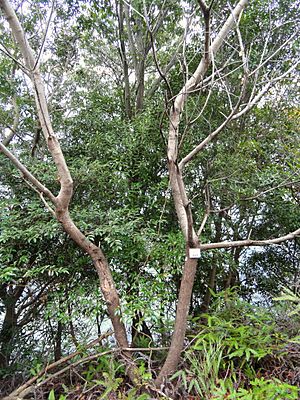Brucea javanica facts for kids
Quick facts for kids Brucea javanica |
|
|---|---|
 |
|
| Scientific classification | |
| Genus: |
Brucea
|
| Species: |
javanica
|
Brucea javanica, also called Macassar kernels, is a type of shrub or small tree. It belongs to the Simaroubaceae plant family. Its scientific name, javanica, means "from Java" in Latin. People also call it Java brucea or kosam.
What Does It Look Like?
Brucea javanica can grow as a shrub or a small tree, reaching up to 5 meters (about 16 feet) tall. Its tiny flowers are usually greenish-white, greenish-red, or purple. They are only about 1.5 to 2 millimeters wide.
This plant has both male and female flowers on the same plant. This is called being monoecious. The parts of the flower that hold pollen (called anthers) are usually red.
The plant typically blooms in June and July. Its fruits grow in July and August. Each fruit is small, about 0.5 centimeters (0.2 inches) long. When they are ripe, they are black-gray and look wrinkled when dry. Inside, the seed is yellowish-white and has an oily coating.
The leaves of Brucea javanica are made up of several smaller leaflets. There are usually 7 to 9 leaflets, but sometimes there can be 3 to 15. Each leaflet is shaped like an oval or a spearhead, with jagged edges. They can grow to be 20–40 centimeters (8–16 inches) long. The leaves have fine hairs, especially on the veins and the underside. Every part of this plant tastes very bitter.
Where Does It Grow?
Brucea javanica grows naturally across a wide area. You can find it from Sri Lanka and India all the way to China, Indochina, Malesia, New Guinea, and Australia.
It likes to grow in open areas, in forests that are regrowing, and sometimes even on sand dunes. In Australia, it often grows as a smaller tree under taller trees. It can be found from sea level up to 500 meters (about 1,640 feet) high.
How Is It Used?
The fruit of Brucea javanica was first written about as a medicine in a Chinese book from 1765. This plant contains special compounds called bruceolides. These compounds are known to fight against cancer and parasites.
Traditionally, people have used Brucea javanica to treat problems like dysentery (a type of stomach infection) and malaria. Even though lab studies have shown it can fight malaria, more research is needed to confirm how well it works in people.
In China, a special oil form of the plant has been studied. It was used along with chemotherapy to treat lung cancer patients, and the results looked promising. However, more high-quality studies are still needed to fully confirm these uses.

